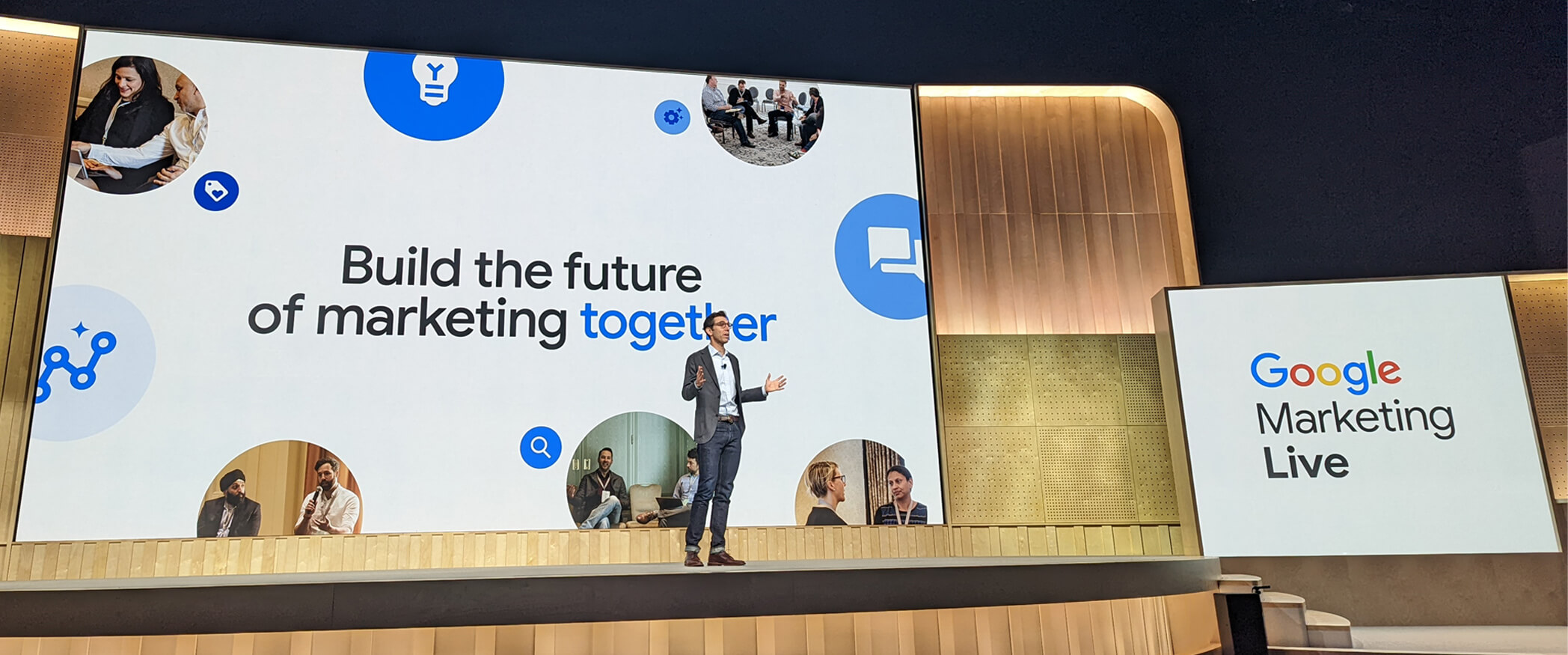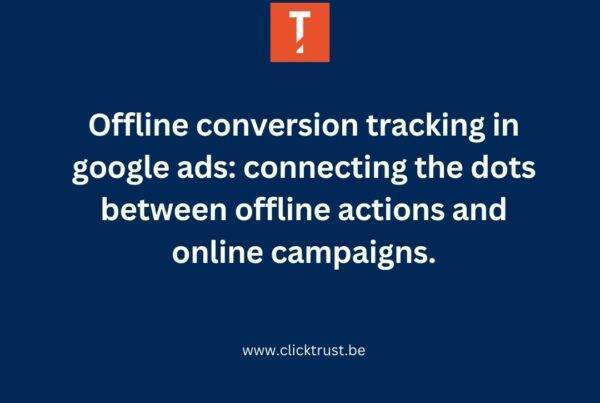Each year, Google shares its latest insights and new products and services during its Google Marketing Live event. This year’s edition focused on three key topics:
1. Reimagine what is possible
2. Driving results
3. Building resilience for the future
Didn’t have time to watch the live broadcast? No worries, we’ve got you covered with a summary of the Google Marketing Live event.
Long-lasting trends and Google’s vision for the future of search
By now, we all know that the pandemic and the accompanying shift to remote created new ways of meeting, working, learning, and entertaining. More than ever, this made all of us what they call “omnibuyers“. That means that consumers are looking for information both online and offline, anywhere and anytime, across multiple channels. To meet the new needs of consumers, Google believes innovation and machine learning are crucial.
Moreover, they believe that people shouldn’t be constrained to just a typical search box. Instead, people should be able to look for the information in a way that is most intuitive to them. Whether that is typing in a search box, asking a question with your voice, searching with your camera, or a combination. With this in mind, they recently started rolling out Multisearch (only available in US). This new tool allows users to take a picture and ask a question at the same time.
Additionally, they are continuing to transform the search result page into an endless stream of visual ideas and information rather than just 10 blue links. According to Google, we shouldn’t just strive to match on keywords alone anymore, but provide rich visual content.
Ads innovations
Online video
Online video is continuing to grow, with the short-form video format exploding in popularity. For that reason, Google started experimenting and gradually rolling out Ads in Youtube Shorts. There is no specific action needed for this, as it is automatically included within video action and app campaigns. Aside from that, they are also testing Video Ads in Google Discover with the idea of offering people a more interactive way of engaging with a brand.
Not only are people watching more online videos, such as on Youtube, but more and more people are also watching them on connected TVs. Google recognized this opportunity and is therefore introducing ‘Google Audiences for connected TV’ in Google Display & Video 360. Concretely, you will be able to use the affinity, in-market, and demographic audiences you already knew across different ad-supported apps, such as Youtube, Hulu, …
Driving results with performance max
It is very clear that Google is strongly pushing forward its newest campaign type, Performance Max. It, therefore, comes as no surprise that a lot of new features for Performance Max are being rolled out in the coming months. The first addition is the experiment tool for Performance Max. This tool allows you to run A/B tests to see if the campaigns are actually driving incremental results.
A frequent complaint of Performance Max is the lack of transparency. It seems like Google heard us as they are adding new insights and explanations to the campaigns. Additionally, they are planning to include Performance Max in the Google Ads optimization score.
Finally, it will be possible to adapt your Performance Max campaigns on the go. Indeed, this campaign type is now also supported in the mobile app, as well as in Search Ads 360.
Delivering the right ads
It is already possible for users to call businesses directly from an ad using call extensions. However, Google is now planning an open Beta with Google Business Messages. This will allow users to not only call but also message your company directly from your ads.
Later this year, Google will also make it possible for responsive search ads to use text directly taken from the pages on your website. A new report will allow you to review these automatically created ads and see how each of them performs.
Furthermore, they are opening their Asset Library for all advertisers. In this tool, you can store and organize all your creative assets, such as images and videos. It can even be integrated with Google Drive. Moreover, it will soon become possible to create simple new videos directly from the Asset library using templates.
Measuring results
Google recently introduced the new intelligent home experience in Google Analytics 4. This experience is based on machine learning algorithms that help you get new insights, as well as make predictions.
Similarly, they are bringing new real-time trends data to the Insights page in Google Ads too. The new Attribution Insights will allow you to compare what is going on across the different Google Ads channels. Budget Insights, on the other side, will give you an overview of the budget run-rate of each campaign. This will help you in revising your campaign budget splits. Finally, you will be able to learn more about your first-party data and customer lists using Audience Insights. It is good to know that all of these changes are rolled out at the manager account level as well. Like that, you can get a more holistic view across your different ad accounts.
Lift tests
In the coming months, Google will also bring us Search and Conversion lift tests in both Google Ads and Display & Video 360. These tests will allow you to see the incremental lift in performance. Geo experiments are an example of this. In this type of experiment, you can compare the performance in regions where ads are shown to the performance of regions where they are not.
Commerce innovations
Intuitive shopping
Google is strongly pushing forward its idea of the “One Store” experience, meaning that people shop whenever and wherever they want. Whether that be online or offline. This is also what they are trying to support with their Performance Max campaign type that combines Search, Youtube, and Shopping. Today, these campaigns can already be optimized for store visits and local actions. Soon, however, we will also be able to optimize them towards actual physical store sales.
Last year, Google already made it possible to “window shop” on their platform. They now also let users visualize products in their own homes using Augmented Reality (AR) in Search.
As already mentioned above, they see continuous growth in the popularity of online video. To help us improve our potential reach, they are therefore introducing product feeds in Youtube Search and Youtube Shorts.
Checkout on Merchant
Another innovation Google is working on is what they call “checkout on Merchant”. As the name suggests, this new feature implies that people can click on a “checkout” button directly from Google Shopping. Like this, they are sent to the checkout page immediately rather than having to go through a long checkout process on the website. In the end, this should help improve conversion rates.
Loyalty
Google being able to tell the difference between existing and new customers through customer match, is not exactly new. What is new though is that you will soon be able to showcase several types of loyalty benefits on Google, using Performance Max campaigns. The interesting thing is that you will have the option to show different benefits depending on whether someone is already a customer or not. Examples presented are discounts for loyalty members, free shipping, special deals, and earning points on what you buy, …
Product improvements in Google Ads
To help advertisers improve their Shopping Feed, the ‘Products’ tab in Google Ads now also shows ‘product improvement’ information. This can help you improve the quality of your shopping feed. Examples include inactive products, missing attributes, and your competitiveness compared to competitors, … Like this, you can not only optimize the performance of your campaigns but also of your individual products.
Building resilience for tomorrow
Privacy-safe advertising
Users will soon be able to control the ads they see in Search, Youtube, and Google Discover using ‘My Ad Center’. They will have the option to see fewer ads from specific categories or from specific brands. Meanwhile, users will also be able to choose to see more ads for their favorite brands and categories. Google promises that this is good news for advertisers as well. After all, we want to talk to a relevant and interested audience.
Moreover, they are expanding their tests with interest-based advertising and remarketing in Google Ads and DV360. This will incorporate the signals from the Privacy Sandbox APIs. Unfortunately, Google didn’t go into detail about this yet.
New customer acquisition
Google has already enabled ‘New Customer Acquisition’ with Customer Match for Performance Max. They are now planning to expand this to all campaign types in the course of this year. With ‘New customer acquisition’, you can bid higher for new customers than for existing ones. Or you can even choose to bid for new customers only.
Marketing-mix modeling
In the future, conversion modeling will become more and more important. We are therefore happy to hear from Google that they are investing in improving its coverage, accuracy, and consistency. These efforts include the expansion to more browsers and new model types.
Though we still believe that you should approach data-driven attribution with caution, Google is strongly pushing forward this attribution model. As of this year, it will become the default attribution model for most new conversion actions. Moreover, it is now available to all advertisers regardless of conversion volume.
Simplified tagging
In the coming weeks, Google will launch the ‘Google Tag’, a replacement for the global site tag. This tag will allow us to combine tags and manage their settings centrally.
Enhanced conversions
We are already familiar with enhanced conversions. This year, however, Google is expanding this with Enhanced Conversions for Leads by allowing you to import your offline conversions. The new Lead funnel report will help us to see how our qualified and converted leads are performing along the funnel. This, in turn, should assist us in automated bidding based on the value of those leads.
On top of that, Google is running a Beta on enhanced conversions in Search Ads 360 and making them available in tools like Hubspot, Tealium, mparticle and Adobe.
Recevez notre newsletter &
nos insights
Nous approfondissons les sujets brûlants du marketing numérique et aimons partager.

